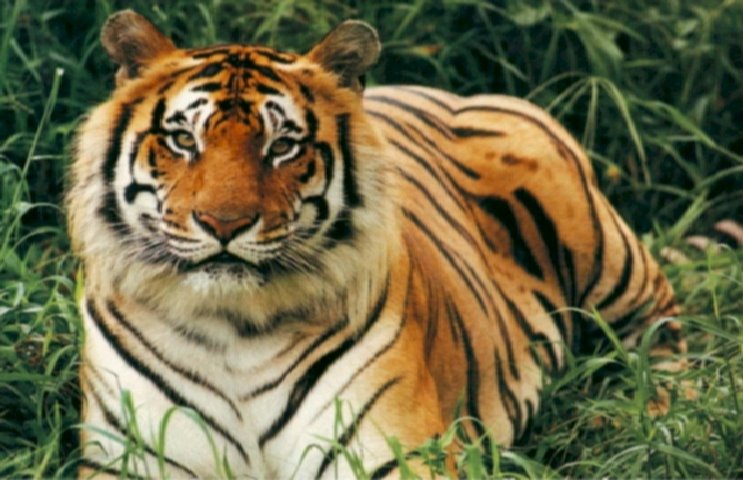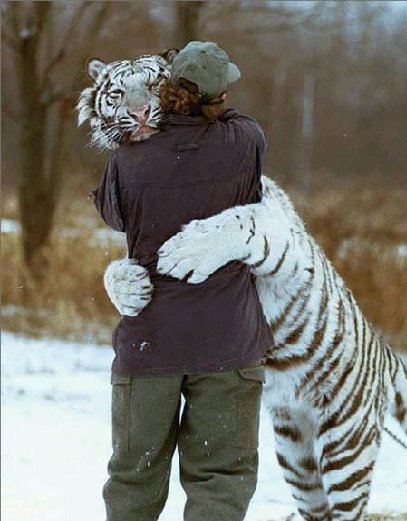THE INDIAN TIGERS
Tuesday 26 June, 2007
Monday 25 June, 2007
ANCESTRY
 1.Fossil evidence shows that catlike carnivores first appeared about 35 million years ago. These were the saber-tooth cats, which had long, daggerlike canine teeth. Saber-tooth cats became extinct less than a million years ago and belonged to a separate ancestral branch than modern cats.
1.Fossil evidence shows that catlike carnivores first appeared about 35 million years ago. These were the saber-tooth cats, which had long, daggerlike canine teeth. Saber-tooth cats became extinct less than a million years ago and belonged to a separate ancestral branch than modern cats.
2.Early modern cats appeared about 25 million years ago and had civet-like features.
3. Tigerlike cats appeared more than 2 million years ago. Tigers are believed to have originated in eastern Asia where some of the earliest fossils have been found. The eight subspecies developed over time as tigers spread to other regions.
Posted by
SUNIL MOHAN
at
7:38 pm
61
comments
![]()
Friday 22 June, 2007
WHY SHOUD WE SAVE TIGER
Why should a species that is always blood-thirsty be conserved? Why should huge government and international funds go in for the safety of the tiger when so many human lives are living in poverty and misery. The answer to the question is not as simple as it seems. For sure, the lives of fellow human beings are precious, but the survival of the tiger is no less important.Unfortunately we, the human beings do not live in isolation. Unfortunately we co-exist in an intense network of species and sub-species. The human beings evolved as a result of evolutionary process that started millions of years ago. From a small, ‘semi-living’, unicellular organism millions of years ago we evolved into what we are today. No doubt we are the most developed and powerful of all the species, but unfortunately even today we are dependent on other species for our daily requirements. Unfortunately all the species, animals or plants, are similarly dependent on each other for their survival.We are all small but important parts of the larger system that keeps us feeding and multiplying. Indian Tiger is also a small but important part of this system. If not for the tiger, it is for our own selfishness that we have to keep a important part of the system alive. For example…the tiger feeds on the herbivorous animals, thereby help keeping their population under control and indirectly saving the jungle from overgrazing. It also feeds on the sick, old and injured animals, thereby helping to keep its prey species healthy. There are hundreds of obvious and not so obvious ways in which the tiger is helps the larger system work.However powerful and intelligent we human beings may be, we cannot ‘create’ life. We can’t even forcefully order a species to multiply. The two sub-groups of Indian Bengal tigers are already extinct. Once the last pair of tigers on the planet die, how much ever we want, desire or try, we will never be able to ‘create’ another tiger.Today this majestic specimen of life- the great Indian Tiger, evolved after millions of years is in danger…just because of the inhuman behaviour of human beings. Tiger is the icon of a heathy and prospering jungle. Biologists believe that if in a jungle tigers are surviving and multiplying, then every thing else in the forest is well. The tiger’s presence itself is a symbol of growth and well being.....
IF YOU LIKE IT PASS IT ON TO YOUR FRIENDS AND THIS IS HOW WE CAN SPREAD AWARENESS
Posted by
SUNIL MOHAN
at
3:36 am
0
comments
![]()
DID YOU KNOW THIS
In the north-east region of the country, Nagas believe that both man and the tiger are sons of the same mother. Although siblings, one took birth in the shape of a man and the other in the form of the striped tiger. Man stayed at home while the tiger went to the jungle. Later, due to some reason, the brothers were forced to fight against each other. Man forced the tiger to jump into the river and killed him. Floating downstream, the animal body was discovered by the Naga God, who sat on it for 10 years and gave birth to hundreds of tigers.All over its habitat, tiger and shades of its existence can be seen finely woven with the local culture and tradition. All over, one comes across thousands of anecdotes about the beast; both inspiring and terrifying. All over India one can find images, statues, and paintings of the tiger, yet this beautiful animal is in constant danger from the human race whose inborn nature is to defy while admiring.
Posted by
SUNIL MOHAN
at
3:34 am
0
comments
![]()
Thursday 21 June, 2007
SAVE THE TIGER
Tiger number in India have fallen by more than half in just ten years confirming conservationists worst fears that previous "official" figures were grossly over-inflated.
Royal Bengal tigress Krishna sits with her cubs at the Alipore Zoological Garden in Calcutta, India
Preliminary results from a major Indian government census on the Bengal tiger show there may be as few as 1,500 left in the wild with the species rapidly heading for extinction.
The scientific survey was ordered by the government in 2005 after it emerged that one of India's leading tiger reserves, Sariska in Rajasthan, had been completely emptied of tigers, provoking a national scandal.
Early results from India's tiger heartlands - the four central Indian states of Madhya Pradesh, Rajasthan, Chattisgarh and Maharashtra - show that numbers have fallen by up to 65 per cent in the worst affected areas.
In Madhya Pradesh, the state that is home to the greatest concentration of Indian tigers, it is now estimated that there are 259 surviving animals, down from 710 in the 2003 census - a fall of two-thirds.
advertisement
Ariel Turn to 30 MPU, advert_format=Flash Banner, advert_id=12881, site=telegraph_living -->
if(command.indexOf('tz')!=-1)eval(command);
The figures bear out the claims of leading conservationists that India's previous "official" figure of 3,624 wild tigers was grossly over-inflated and that the true number was closer to 1,500.
More detailed results from the survey are due to be published in December, however they are not expected to buck these downward trends which show a near disastrous drop-off in numbers.
Rampant poaching, habitat encroachment as well as Chinese and Tibetan demand for skins and body parts reaching unsustainable levels are being blamed.
However, officials have cautioned that the new numbers in part reflect improved, scientific survey methods rather than actual losses of animals to poachers. Whatever the reasons, the reduced tiger numbers are no longer in doubt.
The survey by the Wildlife Institute of India (WII) used camera traps to identify individual tigers by their unique stripe patterns as opposed to the discredited method of counting pugmarks - tiger footprints - which led to an over-estimate of tiger numbers.
Belinda Wright, head of the Wildlife Protection Society of India, a leading tiger conservation charity in India, said the census data should provide a final opportunity for a fresh start in the campaign to save India's dwindling tiger population.
"Let's not play the numbers game. At last we can start dealing with reality and once and for all shelve the fallacies of the past which grossly over-inflated the numbers of tigers in India. Now we know the numbers we need to start dealing with the problem," she said.
Among the most disturbing information provided by the survey is the lack of suitable prey for tigers living outside India's protected forest reserves and national parks.
At the last major tiger census it was estimated that two-thirds of all Indian tigers were living outside the protected reserves and without sufficient food, those numbers are expected to fall rapidly.
"The prey populations are much higher inside the protected areas," said Qamar Qureshi, a scientist with the WII, "prey distribution outside the protected forest is very, very poor and can't sustain tiger populations."
Conservationists now estimate that there are only two major viable and sustainable tiger populations in India - the Corbett range in Uttarakhand and the Kanha range in Madhya Pradesh - which still have the required numbers and habitat range.
The fate of the Indian tiger is also under further threat from Chinese plans to re-open their domestic market in trade in tiger parts, using farmed tigers which now number up to 5,000 in the Chinese mainland.
A high-level delegation of Chinese diplomats has been in New Delhi lobbying the Indian government for support in lifting the ban ahead of a meeting of the Convention on International Trade in Endangered Species (CITES).
Supporters of the scheme say using farmed tigers will reduce demand for illegal supplies of tiger which come mainly from poachers in India and provide a viable long-term source of body parts for traditional Chinese medicine.
However an international coalition of 35 of the world's leading tiger conservation groups has condemned the plans, saying it will have a precisely opposite effect - fuelling demand, increasing poaching and hastening the demise of the species.
Posted by
SUNIL MOHAN
at
7:39 pm
2
comments
![]()
Labels: SAVE US
Wednesday 20 June, 2007
Bengal Tigers
The wild Bengal tiger is the largest found tiger in India. The World Conservation Union Cat Specialist Group has estimated between 3,250 - 4,700 Bengal tigers in the Indian sub-continent. There are 66 different protected zones for the Bengal tigers in India. There are 3 protected zones for Bengal tigers in Nepal inhabiting around 150-250 tigers, 4 protected areas in Bhutan housing 50-250 tigers, 3 protected areas in Bangladesh housing 300-450 tigers. The number of wild Bengal tigers in Myanmar is unknown. Bengal tigers have been captivated in zoos since 1880. The first zoo in India to provide habitat to the tigers was the Alipore Zoo in Calcutta. They have been bred so successfully in captivity that there are astonishingly high captive Bengals today. Many are sent to sanctuaries to live out their lives. The International Tiger Studbook says the total captive population of pure- bred (there has been a lot of crossing of pure Bengals with tigers of unknown descent) Bengal tigers is 333. Of those 333, 289 have the orange color typical of tigers and the remaining 44 are white. All of the pure strain captive Bengal tigers are housed in zoos in India except for 1 pure strain female Bengal tiger that is housed in the United
Posted by
SUNIL MOHAN
at
9:58 pm
3
comments
![]()
INDIAN TIGERS
Tigers are well known for their immense strength and power. They are known to bring down animals weighing almost ten times their own weight and then dragging them away to shelter. A tiger itself weighs between 130 - 180kgs. A majority of this consists of muscle mass as the skeleton itself is relatively small and fragile. Tigers grow to an average height of 90cms. Their main prey species are herbivores, the favourites being Sambhar and Spotted deer. They eat an average of 5 kgs in a sitting and can eat up to 25 kgs in a day. A kill can feed a tiger for 2 - 4 days. Tigers mostly do not try and make another kill immediately after finishing with the previous one. They usually give a 2-3 break before setting out on the next hunt. They have a life expectancy ranging from 15 - 20 years. Their breeding season begins towards the end of the monsoons and carries into the early months of winter. The mates stay together for a period of approximately 10 days. The gestation period is a short one of 105 days. Tigresses give birth to 3 - 6 cubs.
Posted by
SUNIL MOHAN
at
9:04 pm
5
comments
![]()





